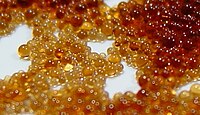
Photo from wikipedia
Proton conduction underlies many important electrochemical technologies. A family of new proton electrolytes is reported: acid‐in‐clay electrolyte (AiCE) prepared by integrating fast proton carriers in a natural phyllosilicate clay network,… Click to show full abstract
Proton conduction underlies many important electrochemical technologies. A family of new proton electrolytes is reported: acid‐in‐clay electrolyte (AiCE) prepared by integrating fast proton carriers in a natural phyllosilicate clay network, which can be made into thin‐film (tens of micrometers) fluid‐impervious membranes. The chosen example systems (sepiolite–phosphoric acid) rank top among the solid proton conductors in terms of proton conductivities (15 mS cm−1 at 25 °C, 0.023 mS cm−1 at −82 °C), electrochemical stability window (3.35 V), and reduced chemical reactivity. A proton battery is assembled using AiCE as the solid electrolyte membrane. Benefitting from the wider electrochemical stability window, reduced corrosivity, and excellent ionic selectivity of AiCE, the two main problems (gassing and cyclability) of proton batteries are successfully solved. This work draws attention to the element cross‐over problem in proton batteries and the generic “acid‐in‐clay” solid electrolyte approach with superfast proton transport, outstanding selectivity, and improved stability for room‐ to cryogenic‐temperature protonic applications.
Journal Title: Advanced Materials
Year Published: 2022
Link to full text (if available)
Share on Social Media: Sign Up to like & get
recommendations!